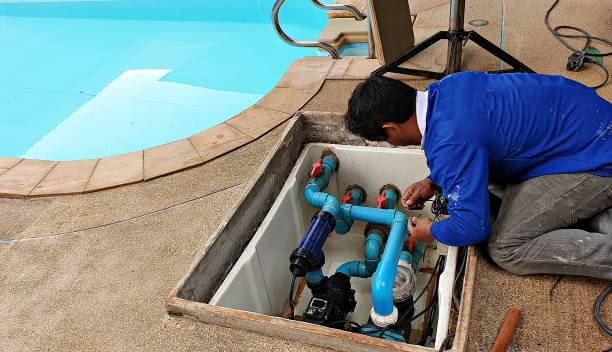Welcome to sainsider.co.za, a comprehensive platform for anything South Africa. In this article, we will be talking about swimming pool repairs in South Africa. Kindly stay with us.
Overview
It takes time and effort to keep your swimming pool in excellent condition. It can also deplete your financial resources. While some people find cleaning their pool therapeutic, others would rather lay poolside in the sun than maintain it! But what is the best approach to keep your swimming pool clean and in good working order?
What To Look At Before Hiring A Pool Team
If you’re considering about hiring an experienced pool maintenance company to look after your pool, you’re probably curious about what they’re doing. Pool servicing will include the following on a monthly or biweekly basis:
1. Make skimming and scrubbing a part of life
Skimming leaves and debris off the surface of the water on a daily basis is recommended for a completely immaculate pool. If you have some extra cash, consider purchasing a robot vacuum that can clean the bottom of your pool for you. In addition to skimming, you should brush the pool’s sides to prevent algae buildup. Scrubbing once every other week is plenty. For exceptionally obstinate places, fill an old sock with chlorine and place it on top of the spot for a few hours before cleaning again.
2. Think of the filter as your pool’s kidneys
Your pool’s filter, like your kidneys, is responsible for eliminating pollutants from the water – think dirt, leaves, and even small toys. Turning off the filter, removing the filter cap placed on the pool deck, lifting out the filter basket, and removing any debris before replacing everything is usually enough to clean the pool. It is recommended that you wipe out your filter basket at least once a week. You should also clean out the pipes used by your filtration system once a month, which you may do by backwashing. Simply turn your filter back on, remove the leaf basket, and clean it out.
3. Pools need consistent chemical levels
Chemical levels are, without a doubt, one of the most critical aspects of pool upkeep. Improperly balanced water seems murky, irritates skin and eyes, and can encourage bacteria to thrive in your pool. You should ideally test the water at least once a week. According to the Centers for Disease Control (CDC), six chemical levels must be considered:
- Cyanuric Acid – protects chlorine from sunlight and determines the required free chlorine level. An ideal reading for outdoor pools is 30 to 50.
- Free chlorine – a sanitizer which keeps your pool water safe and free of germs.
- Acidity/alkalinity – also known as the PH level, acidity needs to be kept between 7.5 and 7.8 to prevent irritation and protect the pool equipment from eroding.
- Total alkalinity – helps keep the PH in balance. Levels should be within range of 60 to 120.
- Calcium hardness – appropriate levels help prevent plaster damage. Aim for 220 to 350, but lower for pools with vinyl siding.
It is simple to test the water. Simply purchase a few testing kits from your local pool retailer and fill them with a sample of the water in your pool. Close the vials after adding the given solution to the testing kit. After a few seconds, the color of your sample water will change, and comparing it to the colors given on the testing kit should allow you to identify the current chemical levels. To create an optimal equilibrium, you should alter the values as needed. When all of the ingredients have been properly balanced, the water should be crystal clear, odorless, and leave very little residue on your skin.
4. Try baking soda instead of chemicals
Most pool stores recommend using sodium bicarbonate to control pool alkalinity without severely lowering PH levels. Regular baking soda does the same function as sodium bicarbonate at a quarter of the cost. Sodium bicarbonate is even featured on the ingredients label of all baking soda boxes. Baking soda has the same sodium bicarbonate content per pound as the solutions, so the quantity you’d need to add to your water would be the same.
5. Don’t be afraid to shock a cloudy pool
Shocking is the process of dramatically increasing chlorine levels for a brief period of time in order to eliminate microorganisms. It is accomplished by diluting three to five times the typical quantity of chlorine or other chemical sanitizer with water, slowly pouring it into the pool’s return line, allowing it to filter throughout the pool, and then gradually replenishing the pool with water over time. While shocking your pool too frequently may cause siding damage, you should attempt to shock it at least twice per season.
6. You need to keep an eye on the water level
You want to keep the level of your skimmer halfway up the entrance. If the water level falls below a certain level, simply use a garden hose to replenish it. If the water level becomes very high, rent a submersible pump from a home improvement store to drain the surplus. However, if your pool’s liner is made of vinyl or fiberglass and could be easily harmed by the weight of the pump, see a specialist. Remember to recheck the chemicals once you’ve reached the proper water level. The changes in water level will have put them off balance.
7. Use a tennis ball to absorb oils
When swimmers leave the pool, certain oils – suntan lotion, hair product, and natural oils produced by our skin – might be left behind in the water. Toss a tennis ball into the water. The fibers used to construct the tennis ball will aid in the absorption of the oils, preventing them from producing a slick sheen on top of the water.
Thank you for reading our todays topic on swimming pool repairs in South Africa. we hope to see you again.
